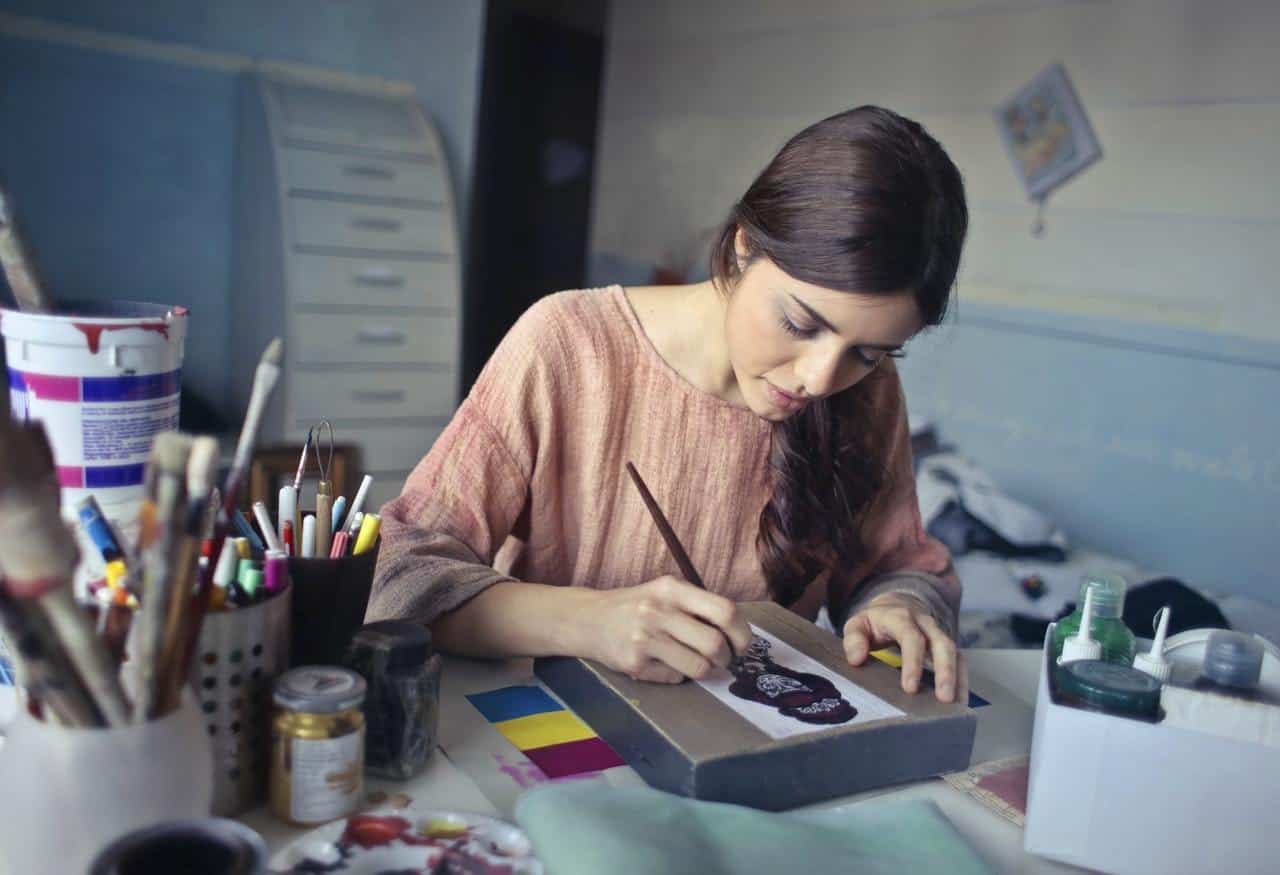Do you find yourself at art shows and museums analyzing what the artist may have been thinking when they made their work? Are you deeply sensitive to the concerns of others? Do you want to help people by using your talents as an artist? If you answered yes to these questions, an art therapy career could be the perfect choice for you.
Art therapists help everyone from children to people with PTSD, using art to guide the therapy process. If this is your first time hearing about art therapy or you’re just not sure exactly what it takes to become an art therapist, we’ve got you covered. We’ve put together this handy guide on how to get started in art therapy, which will cover how to become an art therapist, what’s involved in an art therapy career, and how to put together a stellar online portfolio website that will help you get more art therapy clients. Let’s get started!
What Is an Art Therapist and What Do They Do?
Art therapy is a form of therapy that involves using various art forms to help people explore their emotions, improve their social skills, cultivate resilience, reduce anxiety, and develop insight into their mental state.
Art therapists use techniques like drawing, sculpting, painting, collage-making, and coloring to encourage their clients to express themselves artistically. They ask questions about their client’s creative thought process to understand the underlying messages being communicated in their art, and then employ psychotherapeutic counselling practices to help the client understand their own mental challenges and build relevant coping skills.
Where Do Art Therapists Work?
There are many different careers in art therapy, so your workplace can be as unique as you are. Art therapists may work with individuals, couples, families, children, or groups in a wide variety of settings. Here are some of the places that you could end up working as an art therapist.
Healthcare
As an art therapist, you could be employed in inpatient care in hospitals or other healthcare settings, including outpatient clinics, rehabilitation centers, mental health units, children’s units, disordered eating clinics, and treatment centers, just to name a few. In these settings, art therapists often find themselves dealing with people experiencing addiction, developmental challenges, physical health conditions, mental health issues, and depression, as well as trauma or PTSD.
Seniors’ homes
Art therapists can also work with senior citizens in long-term care homes, hospices, and palliative care facilities. Art therapy can be a very effective way to give seniors increased energy, improve their cognitive skills, reduce feelings of isolation through social interaction, and help them deal with grief and the loss of their cognitive and physical functions.
Schools
In addition to working with children in a hospital or private practice setting, some art therapists work directly in schools.
Correctional Institutes
Some art therapists do work with inmates in a prison setting. Art therapy can provide incarcerated people with a form of catharsis that allows them to express their feelings without discussing them—something they may feel uncomfortable doing (or could even be dangerous in a prison context). Inmates who participate in art therapy may notice a decrease in their disciplinary reports and reduced recidivism.
Private practice
In addition to working as an employee, art therapists can open their own practices where they see clients on their schedule. You could choose to see your therapy clients at your office space, or you could provide online art therapy sessions.
Do I Need To Get an Art Therapy Degree to Work as an Art Therapist?
In order to get an entry-level art therapy job, you’ll need to have a master’s degree in art therapy. Several colleges and universities in the United States and Canada offer degrees in art therapy, which teach students about visual arts, the healing power of engaging with the creative process, and psychological theory.
Some colleges offer undergraduate pre-professional art therapy major programs, but an art therapy undergraduate degree will not be enough to allow you to begin working in the field.

How Long Does It Take To Be an Art Therapist?
If you’re considering starting a new career in art therapy, you probably want to know what you’re in for in terms of art therapy degree requirements and the amount of time you’ll need to commit before you can start making money as an art therapist. Art therapy master’s degrees are generally offered as a two-year program, and involve completing at least 700 hours of supervised practice.
How Do I get Into Art Therapy School?
Students looking to enter an arts therapy master’s program should first take an undergraduate degree in fine arts, psychology, social work, or counselling. If you have already completed an undergraduate degree in a different program, you can undergo a learning assessment where the art therapy school admissions officers determine if you have an equivalency. Since art therapy involves two disciplines, it is strongly recommended that you at least take some art and psychology courses before applying to an art therapy education program.
In addition to completing the educational requirements for art therapy admission, you’ll also need to be able to demonstrate during the admissions process that you understand and have an interest in visual arts and the creative process. This is to ensure that you have the potential to effectively use art as a therapeutic method. Usually this will involve an interview with someone from the art therapy program, where you’ll also be able to show off your art portfolio—so you’ll want to make sure you have a strong one!
Don’t have an online portfolio yet? Check out this great advice from professors and grads on creating an art portfolio for school.
What Should I Look for in an Art Therapy College?
It’s important to make sure the art therapy college you’re looking at meets the educational standards of your country’s professional art therapy association. If it doesn’t, you won’t be able to become a registered art therapist and establish your practice after finishing the program. Both the American Art Therapy Association (AATA) and the Canadian Art Therapy Association (CATA) have databases online of schools with approved art therapy programs.
Is It Possible To Get an Art Therapy Degree Online?
Some art therapy colleges do offer distance or online learning options, but there are considerably less of these options than there are in-person art therapy programs. For example, in Canada, only three of the nine art therapy training programs offer distance learning. Be leery of any online-only institution claiming to offer art therapy degrees, and make sure you do your research into any school before you enroll.
How To Become a Certified Art Therapist
While graduating from an art therapy master’s program is enough to allow you to begin working in an entry-level art therapy job, you also need to apply to your national professional association to get an art therapy certification, which will make you a registered art therapist. Here’s how to get certified in the United States or Canada.
United States
After graduating from an art therapy graduate program that meets the educational standards of the AATA, you need to apply for credentials with the Art Therapy Credentials Board. New graduates will start as a provisional registered art therapist, and then eventually move up to become a registered art therapist. You can even go further and become board-certified, which is the highest art therapy certification that you can receive in the United States.
Canada
Once you complete an art therapy graduate program, you can become a professional member of CATA, which means you agree to abide by the association’s standards of practice and have your professional development supervised by a registered Canadian art therapist.
After being a professional member for six months, completing a set number of face-to-face art therapy sessions hours supervised by a registered art therapist, and submitting paperwork associated with your art therapy master’s program, you can become a registered Canadian art therapist.

What Kind of Art Therapist Salary Should I Expect?
Your art therapist salary will depend on your experience and where you live. According to the U.S. Bureau of Labour Statistics, which classifies art therapists as recreational therapists, the average master’s in art therapy salary (as of May 2017) was $49,670.
Professionals in the top 10% of that category earned $74,210. Job search engine Neuvoo estimates that art therapy careers can net salaries of between $56,000 and $85,000 a year, based on previous job postings on its site. Generally speaking, art therapists working in big cities will likely have higher earning potential than those in smaller towns.

What Is Involved in Doing Art Therapy With Children?
Art therapy for children involves helping children express and document their experiences and perceptions, and what they feel and imagine, through art. It’s a particularly useful method of therapy for children who struggle to explain what they’re feeling, especially those who have experienced abuse, are on the autism spectrum, or have developmental or learning disabilities. As an art therapist, you can let the children you’re working with decide on the art materials they’d like to use, what they want to create, and what they’d like to discuss, in order to encourage their independence and self-regulation.
Art therapy for kids is sometimes confused with play therapy, but they aren’t the same. Play therapy often involves art, but with art therapy, creating a tangible final product is a necessary part of the experience.
How Do I Get Art Therapy Clients?
A great way to connect with potential clients is by becoming a registered member of a professional art therapy association. This will often allow you to become part of their online directory and access other helpful tools and resources. For example, in Canada, registered Canadian art therapists are included in CATA’s online directory for clients who are looking to find an art therapist. It’s also a good idea to network with other art therapists so that they can recommend you if an opportunity comes up.
Don’t Forget To Build an Online Art Therapy Portfolio
Having an online art therapy portfolio can help you stand out, make a strong impression, and build your art therapy client base. Prospective art therapy clients can get a sense of your artistic bona fides, your practice, and your guiding philosophy when it comes to making art. Plus, once you’re more established as a professional art therapist, you can also use your portfolio to display client testimonials and show off the finished works of some of your clients to demonstrate what you do.
If creating your own art therapy portfolio feels overwhelming, don’t worry! These days, it’s easier than ever to use a website builder to make a professional online portfolio website in a matter of minutes with no knowledge of coding required. Make sure that you choose a portfolio builder that offers tons of gorgeous award winning website templates and an intuitive design editor.
In addition to uploading images of your artistic creations, you can include galleries of your client’s work, and make use of the image captions to add context about how you helped them through art therapy. Since your potential clients need to be able to trust your authority as an art therapist, your online art therapy portfolio is also the ideal location for you to write a standout About Me page where you can list all of your art therapy credentials.
Now that you know everything there is to know about what it takes to become an art therapist, it’s time to get out there and help people through art. Art can be such a healing force in life—here’s to spreading the joy!
Want more tips on how to succeed as an artist?
Self Care Ideas for Artists
Here Are The Top 9 Cities for Artists to Live In
Curate That Site: How To Choose Which Portfolio Images To Use












